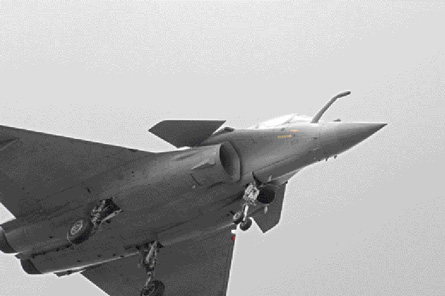Jon Lake reports on the aircraft widely expected to be one of the highlights of Le Bourget
For many French visitors to Le Bourget, there will be no doubt about the star of this year’s Paris Air Show. The Rafale is now in full front-line service, flying operational missions over Afghanistan even as the show continues, and is regarded by many as being the towering achievement of the French aerospace industry.
The aircraft has proved itself in numerous exercises, and has already gained a formidable reputation among those who have encountered it.

Already an extremely effective multi-role tactical fighter, development work is continuing apace to exploit more and more of the aircraft’s planned capabilities, and to add new ones. As a result, a good aircraft looks set to become even better, and closer to fulfilling Dassault’s ambitious claim that the aircraft is an omni-role fighter – an aircraft capable of conducting air-to-air and air-to-ground tasks during the same mission.
Ambition
Today’s Rafale is still short of that lofty ambition, with the bulk of the Aéronavale’s single-seat Rafale M aircraft still to the original F1 avionics standard, limiting them to air-to-air and tanker duties, and with the Armée de l’Air concentrating on the air-to-ground role for its F2-standard two-seat Rafale Bs and for its handful of single-seat Rafale Cs.
But the aircraft are extremely capable in the air-to-air role, though many configurations involving mixed loads of air-to-air and air-to-ground weapons are still being cleared. During the recent Tactical Leadership Programme exercise in Belgium, the participating Rafales operated in the air-to-ground role – though this did not stop them scoring enough air-to-air kills to emerge with the second best kill:loss ratio in the exercise. And it is widely expected that true multi-role capability will be incorporated soon.
For the time being, Rafale orders stand at 120, of a total French requirement for 294. There were 13 F1 standard aircraft (one C, two Bs and ten Ms), 48 F2 standard aircraft (25 Bs, seven Cs and 16 Ms) and 59 F3 standard aircraft (11 Bs, 36 Cs and 12 Ms). Forty-eight production aircraft have been delivered: two F1 standard Rafale Bs, a single F1 standard Rafale C, ten F1 standard Rafale Ms, 24 F2 standard Rafale Bs, seven F2 standard Rafale Cs and four F2 standard Rafale Cs.
The original F1 standard provided a basic air-to-air capability, with Magic 2, and Mica EM air-to-air missiles and the internal cannon (an interim LF1 standard was briefly limited to Magic only). Some 17 aircraft were delivered to F2.1 standard, adding the AASM boosted guided bomb and air-to-ground functionality to the aircraft.
By the time the first Armée de l’Air unit stood up in June 2006, all air force aircraft had been upgraded to the full F2.2 standard, with new modes for the Spectra EW system, and with full compatability with the Scalp stand off missile (though problems with the mission planning software reportedly prevented its full operational employment).
Positive
On a more positive note, the emitter location capability of Spectra, combined with the reach and accuracy of AASM already promise to give the aircraft a useful SEAD capability.
Four development aircraft are now flying in the definitive F3 standard, and production deliveries are expected later this year. The F3 has further radar and Spectra improvements, with a lower false return rate in the terrain following mode, and will allow Rafale to carry the AM39 Exocet anti-ship missile, the ASMP nuclear cruise missile, and the Reco NG reconnaissance pod. The F3 is also expected to be cleared to use the 2,000-lb GBU-24 Paveway III LGB, and the dual mode Enhanced Paveway.
The F3 standard aircraft will not be delivered with the Rafale’s innovative OSF (Optronique Secteur Frontal) system, though this will be able to be fitted if swapped from an F2 standard aircraft, and nor will their Spectra defensive system have the DDM Infrared Missile Detector system.
Though delivered to different standards, there are already plans in place to upgrade early aircraft to the full F3 avionics standard.
Smaller step
To bring the Aéronavale Rafale M F1s to F3 standards would require modifications to, or replacement of ‘seven major sub-systems’, and a technical solution has been proposed, with a new Modular Data Processing Unit replacing several existing LRUs, and with some changes to the ‘back end electronics’ of some equipment and sensors.
Bringing F2 aircraft to the F3 standard is viewed as being a much smaller step – 90-95% of the required changes being achieved via new software.
After the next 59 Rafales are delivered, subsequent aircraft will incorporate further improvements and modifications. The (unofficial) F4 designation once commonly used to describe these aircraft has now fallen out of favour, and the English term ‘Roadmap’ (sometimes translated as feuille de route) is used instead.
Source: Flight Daily News
















